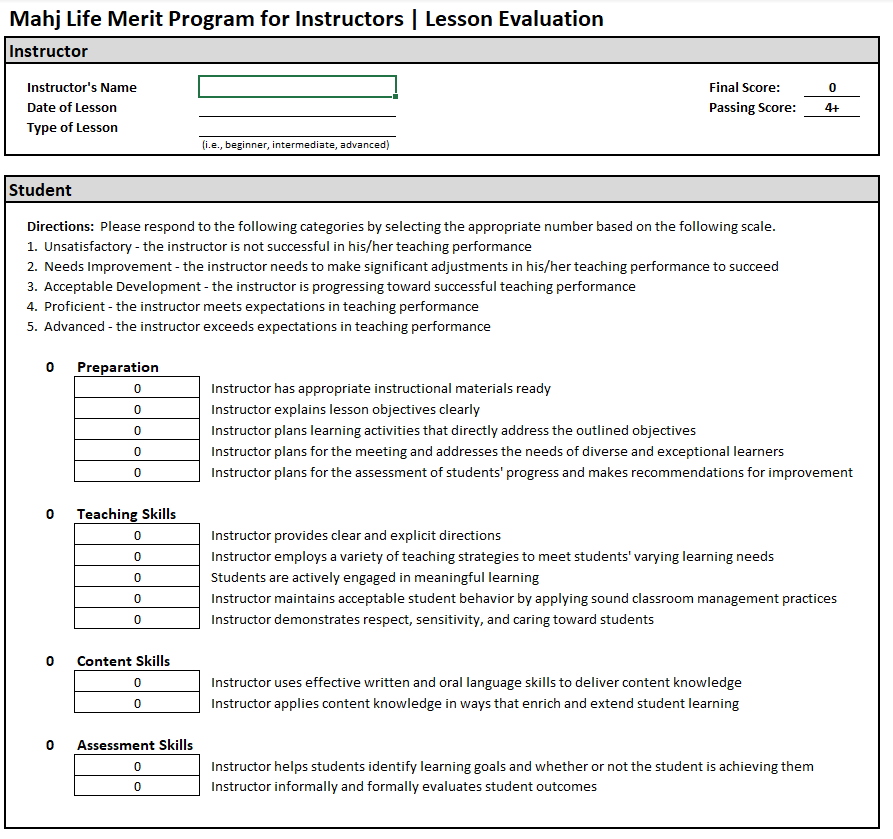Extended-Response Essay Rubric (passing score 40+)
| Criteria | Rating Scale | |||
| Inadequate (0-5) | Adequate (6-7) | Above Average (8-9) | Exemplary (10) | |
| Organization | Writing lacks logical organization. It shows some coherence but ideas lack unity. Serious errors. | The main points lack detailed development. Ideas are vague with little evidence of critical thinking. | Writing is coherent and logically organized with transitions used between ideas and paragraphs to create coherence. Overall unity of ideas is present. | Content indicates the synthesis of ideas, in-depth analysis, and original thinking. |
| Level of Content | Content shows some thinking and reasoning but most ideas are underdeveloped and unoriginal. | Content indicates thinking and reasoning applied with original thought on a few ideas. | Content indicates original thinking and develops ideas with sufficient and firm evidence. | Content indicates the synthesis of ideas, in-depth analysis and original thinking. |
| Development | The main points are well developed with high quality and quantity support. Reveals a high degree of critical thinking. | The main points are presented with limited detail and development. Some critical thinking is present. | The essay is free of distracting spelling, punctuation, and grammatical errors; absent of fragments, comma splices, and run-ons. | Writing is coherent and logically organized. Some points remain misplaced and stray from the topic. Transitions are evident but not used throughout the essay. |
| Grammar & Mechanics | Content indicates the synthesis of ideas, in-depth analysis, and original thinking. | Writing is coherent and logically organized. Some points remain misplaced and stray from the topic. Transitions are evident but not used throughout the essay. | The essay has few spelling, punctuation, and grammatical errors allowing the reader to follow ideas clearly. Very few fragments or run-ons. | Attains college-level style; tone is appropriate and rhetorical devices used to enhance content; sentence variety used effectively. |
| Style | Mostly in elementary form with little or no variety in sentence structure, diction, rhetorical devices, or emphasis. | Fails to follow format and assignment requirements; incorrect margins, spacing, and indentation; neatness of essay needs attention | Approaches college-level usage of some variety in sentence patterns, diction, and rhetorical devices. | Shows outstanding style going beyond usual college level; rhetorical devices and tone used effectively; creative use of sentence structure and coordination. |
| Format | Most spelling, punctuation, and grammar are correct allowing the reader to progress through the essay. Some errors remain. | Meets format and assignment requirements; generally correct margins, spacing, and indentations; essay is neat but may have some assembly errors. | Meets format and assignment requirements; margins, spacing, and indentations are correct; essay is neat and correctly assembled. | Meets all formal and assignment requirements; attention to detail; all margins, spacing, and indentations are correct; essay is neat and correctly assembled with a professional look. |
Download a syllabus template and see an example.
| Criteria | Rating Scale | ||
| Emerging (0-2) | Developing (3-4) | Mastering (4-6) | |
| Course Description | Instructor name and contact info, class time, and location | In addition, lesson prerequisites (if any), and lesson description | In addition, supplemental readings, and resources |
| Overall Tone | Mechanical, dictatorial | Teacher-oriented | Student/learning-oriented |
| Class Schedule | Little or no information on what topics will be covered | Topics are shown in a bulleted list | Fully articulated and logically sequenced schedule with topics shown in a bulleted list along with any required reading and preparation necessary from students |
| Course Format | Vague, or cryptic descriptions of course expectations and how class time will be used | Mutual role expectations for students and the instructor are explained, together with various teaching methods and modes | Role expectations and class format are explained in such a way that students understand the underlying rationale and benefits for them |
| Course Outcomes | Not articulated | Stated in general, but vague and uses unmeasurable terms | Listed with appropriate, descriptive verbs that lend themselves to measurement and seek high levels of learning (see Bloom’s taxonomy) |
| Assessment of Student’s Learning | No information about how the student’s learning will be assessed | Brief information about how the student’s learning will be assessed | Entailed information about how the student’s learning will be assessed |
| Alignment | No clear connection between lesson outcomes and assessments | The apparent connection between lesson outcomes and assessments | The clear connection between lesson outcomes and assessments |
| Variety of Teaching & Assessment Methods | Lesson teaching is all similar (i.e., all lectures), and no indication of assessments | Lesson teaching and assessment methods are similar (i.e., presentation, lectures, written tests, hands-on skill builders) | Lesson teaching and assessment methods are varied (i.e., presentation, lectures, written tests, hands-on skill builders) |
| Continuity of Feedback to Students on Their Learning | No mention of obtaining student feedback on their progress | One method of obtaining student feedback on their progress is mentioned | Several methods of obtaining student feedback on their progress are mentioned |
| Opportunity for Students to Evaluation the Lesson | Students only opportunity to provide a lesson evaluation is at the end of the lesson | The instructor provided a brief evaluation sheet for immediate response or asked for feedback in the chat | The instructor created an in-depth lesson evaluation survey |
See Bloom’s Taxonomy (University of Arkansas) for help with defining course outcomes.
Lesson Evaluation (passing score 4+)
Download the lesson evaluation.

The final results will be provided by email within five business days.
